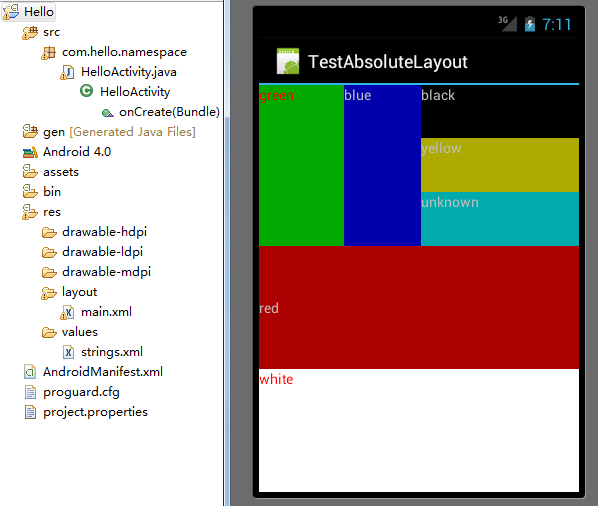
- Android如何获取图片或视频略缩图
- 基于Android AppWidgetProvider的使用介绍
- Android控件之RatingBar自定义星级评分样式
- Android开发笔记之:如何屏蔽Button setClickable与setEnabled
- Android拍照上传功能示例代码
- android使用Messenger绑定Service的多种实现方法
- 简析Android五大布局(LinearLayout、FrameLayout、RelativeLayout等)
- android TabHost(选项卡)的使用方法
- Android中父View和子view的点击事件处理问题探讨
- Android中ArrayList和数组相互转换
- 从零开始学android小示例程序
- Android开发之ListView实现Item局部刷新
- 另外两种Android沉浸式状态栏实现思路
- Android Studio与SVN版本控制程序的协作使用指南
- android实现简单的乘法计算代码
- ANDROID 完美退出APP的实例代码
- Android 监听apk安装替换卸载广播的实现代码
- Android自定义控件简单实现侧滑菜单效果
- Android实现带附件的邮件发送功能
- Android Http实现文件的上传和下载
- Android实现滑动加载数据的方法
- Android判断包名和类名是否存在的方法
- Android中怎样避免创建不必要的对象
- Android6.0来电号码与电话薄联系人进行匹配
- Android 初识 Helloworld 详解
- Android实现APP欢迎页面简单制作思路
- Android App实现应用内部自动更新的最基本方法示例
- Android中通知栏跳动问题解决方法
- Android编程学习之异步加载图片的方法
- Android中Matrix用法实例分析
Android编程之线性布局LinearLayout实例简析
作者:佚名 Android开发编辑:admin 更新时间:2022-07-23
本文实例讲述了Android编程之线性布局LinearLayout用法。分享给大家供大家参考,具体如下:
线性布局(LinearLayout)
可以让它的子元素垂直或水平的方式排成一行(不设置方向的时候默认按照垂直方向排列)。
下面示例是在别人基础上修改的main.xml:
<?xml version="1.0" encoding="utf-8"?>
<LinearLayout xmlns:android="http://schemas.android.com/apk/res/android"
android:layout_width="fill_parent"
android:layout_height="fill_parent"
android:orientation="vertical" >
<LinearLayout
android:orientation="horizontal"
android:layout_width="fill_parent"
android:layout_height="wrap_content"
android:baselineAligned="false"
android:layout_weight="1" >
<LinearLayout
android:orientation="horizontal"
android:layout_width="wrap_content"
android:layout_height="fill_parent"
android:layout_weight="1">
<TextView
android:text="@string/color_green"
android:textColor="#ff0000"
android:background="#00aa00"
android:layout_width="wrap_content"
android:layout_height="fill_parent"
android:layout_weight="1"/>
<TextView
android:text="@string/color_blue"
android:background="#0000aa"
android:layout_width="wrap_content"
android:layout_height="fill_parent"
android:layout_weight="1"/>
</LinearLayout>
<LinearLayout
android:orientation="vertical"
android:layout_width="wrap_content"
android:layout_height="fill_parent"
android:layout_weight="1">
<TextView
android:text="@string/color_black"
android:background="#000000"
android:layout_width="fill_parent"
android:layout_height="wrap_content"
android:layout_weight="1"/>
<TextView
android:text="@string/color_yellow"
android:background="#aaaa00"
android:layout_width="fill_parent"
android:layout_height="wrap_content"
android:layout_weight="1"/>
<TextView
android:text="@string/color_unknown"
android:background="#00aaaa"
android:layout_width="fill_parent"
android:layout_height="wrap_content"
android:layout_weight="1"/>
</LinearLayout>
</LinearLayout>
<LinearLayout
android:orientation="vertical"
android:layout_width="fill_parent"
android:layout_height="wrap_content"
android:layout_weight="2">
<TextView
android:text="@string/color_red"
android:gravity="fill_vertical"
android:background="#aa0000"
android:layout_width="fill_parent"
android:layout_height="wrap_content"
android:layout_weight="2"/>
<TextView
android:text="@string/color_white"
android:textColor="#ff0000"
android:background="#ffffff"
android:layout_width="fill_parent"
android:layout_height="wrap_content"
android:layout_weight="2"/>
</LinearLayout>
</LinearLayout>
string.xml
<?xml version="1.0" encoding="utf-8"?> <resources> <string name="hello">Hello World, TestAbsoluteLayoutActivity!</string> <string name="app_name">TestAbsoluteLayout</string> <string name= "color_red">red</string> <string name= "color_green">green</string> <string name= "color_blue">blue</string> <string name= "color_white">white</string> <string name= "color_black">black</string> <string name= "color_yellow">yellow</string> <string name= "color_unknown">unknown</string> </resources>
效果图如下:

常用的属性:
android:orientation:可以设置布局的方向
android:gravity:用来控制组件的对齐方式
layout_weight:控制各个组件在布局中的相对大小
更多关于Android编程布局相关内容可查看本站专题:《Android布局layout技巧总结》
希望本文所述对大家Android程序设计有所帮助。
- 上一篇文章: Android编程之简单计时器实现方法
- 下一篇文章: Android开发之简单文件管理器实现方法
- Android查看电池电量的方法(基于BroadcastR
- Android控件之TabHost用法实例分析
- Android开发之Animations动画用法实例详解
- Android双击返回键退出程序的实现方法
- Android SD卡上文件操作及记录日志操作实例
- Android App开发中HTTP扩展包OkHttp的入门使
- Android开发中Activity的生命周期及加载模式